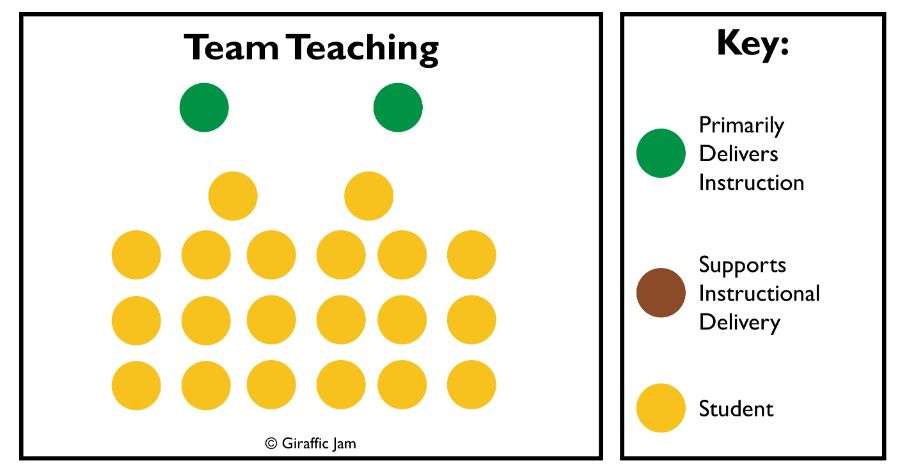
Team teaching is a great co-teaching strategy to try. It’s a perfect strategy to try for those new to co-teaching. Team teaching is when two teachers both present the lesson to the entire class as the same time.
There are six different types of co-teaching. No matter which of the types of co-teaching you use, you and your co-teacher can be highly effective instructors when you work together to plan and deliver lessons. Co-teaching works, because it involves two adults actively working together to provide instruction.
Simply put, co-teaching is when two adults work together to teach a lesson. Notice, I say ‘adults’ not teachers. Why? It’s simple really, it could be two teachers. Or, it could be an intern and a teacher. Or, a substitute and a teacher. Or, an instructional assistant and a teacher. Or, a substitute and an instructional assistant. Or…..
Well, I guess you get where I’m going with this. However, old habits die hard so throughout this post you’ll see me refer to the adults as ‘teachers’. Just don’t limit yourself to thinking of teachers only in the traditional sense!
Don’t be limited to thinking that co-teaching is always a gen ed teacher and a special education teacher. It can be, but it doesn’t have to be. If you think outside the box, you might find that you have more opportunities for co-teaching than you realize!
Team teaching involves both teachers providing the instruction. Both teachers work together to share the responsibility of providing the content and directions. Teachers can take turns talking and ‘jump in’ (politely, of course!) on each other to clarify things that seem to be causing confusion to the students. Both teachers have an equally active role in this co-teaching model.

When team teaching, both teachers work together to deliver the lesson to the entire class. Teachers work together to share responsibilities of delivering the lesson.
If your team has a great working relationship, team teaching is so much fun! A team who works well together can engage in conversation and banter that makes a lesson engaging and interesting to students. The teachers can play off of each other and help to clarify statements that might have been confusing. It’s also a great opportunity to introduce common misconceptions. As one teacher is providing instruction, the teammate could be asking questions that they know a lot of students have but might be afraid to ask. For instance, when talking about adding fractions maybe one of the teachers could model and the other could say something like, “Wait – aren’t we supposed to add the denominators, too?” Then, the teacher modeling could explain why we never add the denominators.
This one can be super challenging to do – especially if one of the teachers isn’t as confident. Both teachers need to be actively engaged in delivering instruction. Otherwise, it becomes a different method of co-teaching. Both teachers need to have clearly defined roles and understand the pacing of the lesson as well as the objectives. Both teachers need to be involved in the instructional delivery.
Co-Teaching can be hard. If you’re looking for more information, check out this blog post to read some of my favorite tips and tricks for getting the ball rolling!
Co-teaching is an effective tool for reaching all of your learners. It allows both teachers the opportunity to see students and their progress. When you use parallel teaching as your co-teaching method, it gives the students the chance to see the lesson in a smaller group setting. Did you know there are five other types of co-teaching? Check them out here!